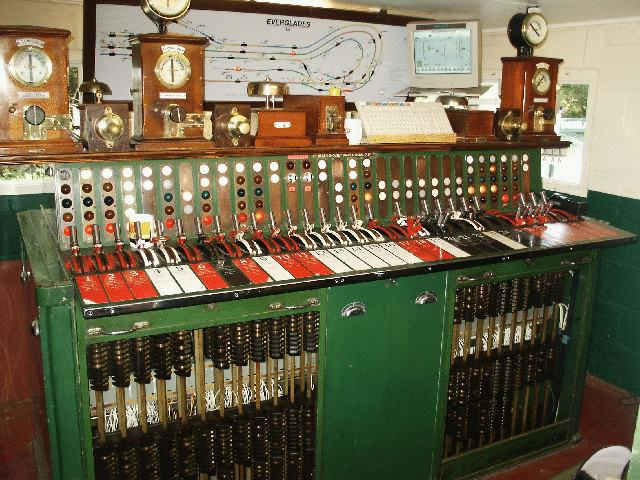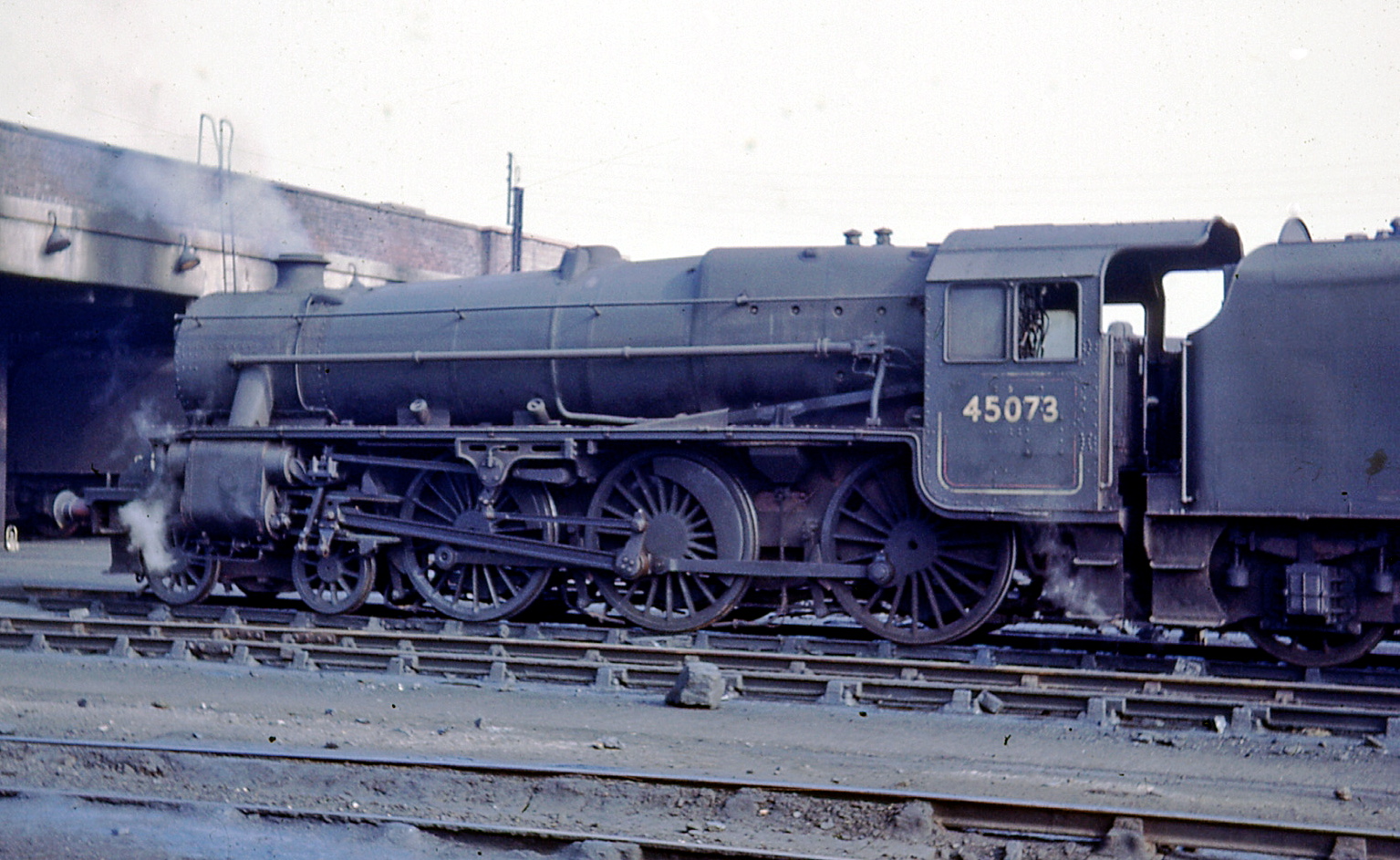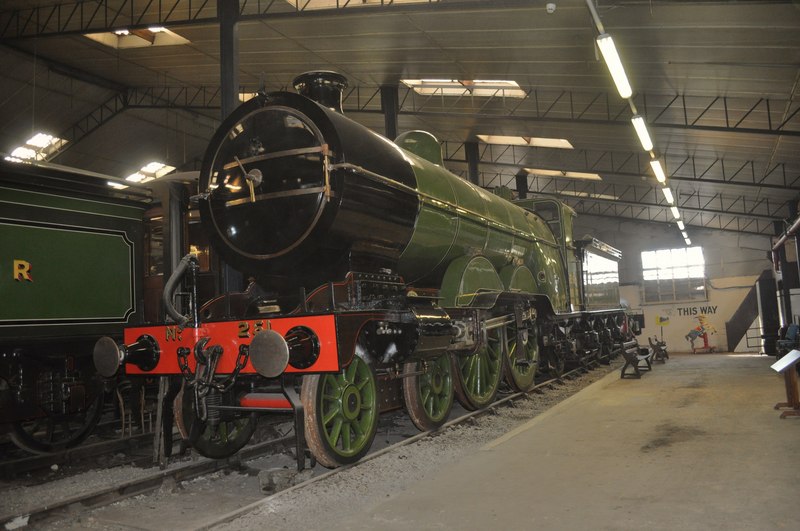|
Great Cockcrow Railway
The Great Cockcrow Railway is a gauge miniature railway located near Chertsey, Surrey, England. It is usually open on Sunday afternoons from May to October inclusive. History This gauge railway originated in 1946 when John Samuel started construction in the garden of his house, 'Greywood', on the Burwood Park estate at Walton-on-Thames. With the help of a group of volunteers the Greywood Central Railway developed until 1962, when a run of was possible. From the first the line was properly signalled and ultimately worked to a timetable. Samuel's death in October 1962 threw the railway's future into doubt but the publisher, Ian Allan purchased the line and, with the assistance of the GCR volunteers, moved it to its present site at Hardwick Lane, Chertsey. It reopened to the public on 14 September 1968 under the new name Great Cockcrow Railway, taken from Cockcrow Hill which rises on its south side. The most recent innovation is a proper station building, completed in 2014 aft ... [...More Info...] [...Related Items...] OR: [Wikipedia] [Google] [Baidu] |
Chertsey
Chertsey is a town in the Borough of Runnymede, Surrey, England, south-west of central London. It grew up round Chertsey Abbey, founded in 666 CE, and gained a market charter from Henry I. A bridge across the River Thames first appeared in the early 15th century. The River Bourne through the town meets the Thames at Weybridge. The Anglican church has a medieval tower and chancel roof. The 18th-century listed buildings include the current stone Chertsey Bridge and Botleys Mansion. A curfew bell, rung at 8 pm on weekdays from Michaelmas to Lady Day ties with the romantic local legend of Blanche Heriot, marked by a statue of her and the bell at Chertsey Bridge. Green areas include the Thames Path National Trail, Chertsey Meads and a round knoll (St Ann's Hill) with remains of a prehistoric hill fort known as Eldebury Hill. Pyrcroft House dates from the 18th century and Tara from the late 20th. Train services are run between Chertsey railway station and London Waterloo by Sout ... [...More Info...] [...Related Items...] OR: [Wikipedia] [Google] [Baidu] |
LNER Class K5
The London and North Eastern Railway Class K5 consisted of a single rebuild of LNER Class K3 2-6-0 Under the Whyte notation for the classification of steam locomotives, represents the wheel arrangement of two leading wheels on one axle, usually in a leading truck, six powered and coupled driving wheels on three axles and no trailing wheels. ... No. 206 (later No. 61863), rebuilt in 1945 by Edward Thompson. The rebuilt locomotive had a new boiler and two, instead of three, cylinders following earlier rebuilds of other Gresley designs. The clear aim of the rebuilds was to move away from the well established three cylinder policy achieving similar results through higher boiler pressure and two larger cylinders. Easier maintenance and greater availability was the objective. Sources * External links The Gresley K3 and Thompson K5 2-6-0 Moguls''LNER Encyclopedia'' Railway locomotives introduced in 1945 2-6-0 locomotives K5 Standard gauge steam locomotives of Great B ... [...More Info...] [...Related Items...] OR: [Wikipedia] [Google] [Baidu] |
LMS Stanier Class 8F
The London, Midland and Scottish Railway (LMS) Stanier Class 8F is a class of steam locomotives designed for hauling heavy freight. 852 were built between 1935 and 1946 (not all to LMS order), as a freight version of William Stanier's successful Black Five, and the class saw extensive service overseas during and after the Second World War. Background LMS freight traction suffered from the adoption of the Midland Railway's small engine policy which had left it with trains double-headed by underpowered 0-6-0s supplemented by disappointing Garratts and Fowler 7F 0-8-0s. The 8F design incorporated the two-cylinder arrangement of the Black Fives. They were initially classified 7F, but this was later changed to the more familiar 8F. On the outbreak of the World War II, the design was chosen to become the country's standard freight design, reprising the role the GCR Class 8K had in the First World War. The War Department had 208 8Fs built by Beyer Peacock and North British Loc ... [...More Info...] [...Related Items...] OR: [Wikipedia] [Google] [Baidu] |
LMS Royal Scot Class
The London, Midland and Scottish Railway (LMS) Royal Scot Class is a class of 4-6-0 express passenger locomotive introduced in 1927. Originally having parallel boilers, all members were later rebuilt with tapered type 2A boilers, and were in effect two classes. Background Until the mid-1920s, the LMS had followed the Midland Railway's small engine policy, which meant that it had no locomotives of sufficient power for its expresses on the West Coast Main Line. These trains were entrusted to pairs of LMS/MR Midland Compound 4-4-0s between Glasgow and , and a 4-6-0 locomotive of the LNWR Claughton Class, piloted by an LNWR George V 4-4-0, southwards to Euston station. The Operating and Motive Power Departments of the LMS were satisfied with the small engine policy. However, in 1926 the Chief Mechanical Engineer, Henry Fowler, began the design of a compound Pacific express locomotive. The management of the LMS, faced with disagreement between the CME and the other departments, o ... [...More Info...] [...Related Items...] OR: [Wikipedia] [Google] [Baidu] |
LMS Stanier Class 5 4-6-0
The London, Midland and Scottish Railway (LMS) Stanier Class 5 4-6-0, commonly known as the Black Five, is a class of steam locomotives. It was introduced by William Stanier and built between 1934 and 1951, of which 842 were built and were numbered 4658-5499 (BR then renumbered 44658-45499). Several members of the class survived to the last day of steam on British Railways in 1968, and eighteen are preserved. Origins The Black Five was a mixed-traffic locomotive, a "do-anything go-anywhere" type, designed by Stanier, who had previously been with the GWR. In his early LMS days, he designed his Stanier Mogul in which he experimented with the GWR school of thought on locomotive design. A number of details in this design he would never use again realising the superiority of details not used on the GWR. Stanier realised that there was a need for larger locomotives. These were to be the LMS version of the GWR Halls but not a copy, as the Hall was too wide to run most places in Br ... [...More Info...] [...Related Items...] OR: [Wikipedia] [Google] [Baidu] |
LNER Gresley Classes A1 And A3
The London and North Eastern Railway LNER Gresley Classes A1 and A3 locomotives represented two distinct stages in the history of the British "Pacific" steam locomotives designed by Nigel Gresley. They were designed for main line passenger services and later express passenger services, initially on the Great Northern Railway (GNR), a constituent company of the London and North Eastern Railway after the amalgamation of 1923, for which they became a standard design. The change in class designation to A3 reflected the fitting to the same chassis of a higher pressure boiler with a greater superheating surface and a small reduction in cylinder diameter, leading to an increase in locomotive weight. Eventually all of the A1 locomotives were rebuilt, most to A3 specifications, but no. 4470 was completely rebuilt as Class A1/1. The names for the locomotives came from a variety of sources. The first, ''Great Northern'', was named after its parent company. Others were given the na ... [...More Info...] [...Related Items...] OR: [Wikipedia] [Google] [Baidu] |
LB&SCR H2 Class
The London, Brighton and South Coast Railway H2 class was a class of 4-4-2 steam locomotives for express passenger work. They were designed when D. E. Marsh was officially Locomotive Superintendent, and were built at Brighton Works in 1911 and 1912. Background In 1911, D. E. Marsh was on leave of absence due to sickness, and his assistant Lawson Billinton was granted authority to construct a further six 4-4-2 'Atlantic' locomotives similar to the Marsh H1 class but incorporating the Schmidt superheater. Construction and use The new H2 class locomotives built by Brighton railway works and introduced between June 1911 and January 1912. They were an immediate success and shared with the H1 class the London to Brighton express trains including the heavily loaded Pullman services the ''Brighton Limited'', and the ''Southern Belle'', which the LB&SCR described as "the most luxurious train in the World". As with the non-superheated class they were gradually replaced on the Lond ... [...More Info...] [...Related Items...] OR: [Wikipedia] [Google] [Baidu] |
GNR Class H4
The Great Northern Railway Class H4 (classified K3 by the LNER) was a class of 2-6-0 steam locomotive designed for mixed-traffic work. The type was a more powerful development of the earlier H3 ( LNER K2) class and was notable at the time, as the boilers were the largest fitted to any British locomotive to that date. After formation of the London and North Eastern Railway, the type became known as class K3 and was adopted as an LNER standard design. They got the nickname "Jazzers" after the rhythm of their exhaust beat and the unbalanced gyratory movement. Construction The first ten locomotives were built at the GNR's Doncaster Works in 1920, to the design of Nigel Gresley. Six further batches were built at Doncaster and Darlington Works, Armstrong Whitworth, Robert Stephenson and Company and the North British Locomotive Company. The last few of 193 examples were delivered in 1937. Use They were excellent mixed-traffic locomotives, although their large size restricted t ... [...More Info...] [...Related Items...] OR: [Wikipedia] [Google] [Baidu] |
SR U Class
The SR U class are 2-6-0 steam locomotives designed by Richard Maunsell for passenger duties on the Southern Railway (SR). The class represented the penultimate stage in the development of the Southern Railway's 2-6-0 "family", which improved upon the basic principles established by GWR Chief Mechanical Engineer (CME) George Jackson Churchward for Great Western Railway (GWR) locomotives. The U class design drew from experience with the GWR 4300s and N classes, improved by applying Midland Railway ideas to the design, enabling the SECR to influence development of the 2-6-0 in Britain.Scott-Morgan, p. 46 The U class was designed in the mid-1920s for production at a time when more obsolete 4-4-0 locomotives were withdrawn, and derived from Maunsell's earlier SECR K (“River”) class 2-6-4 tank locomotives. The first 20 members of the U class were rebuilds of the K class locomotives, one of which was involved in the Sevenoaks railway accident. A further 20 U class l ... [...More Info...] [...Related Items...] OR: [Wikipedia] [Google] [Baidu] |
GNR Class C1 (large Boiler)
The Great Northern Railway (GNR) Class C1 is a type of 4-4-2 steam locomotive. One, ex GNR 251, later LNER 2800, survives in preservation. Much like their small boiler cousins, they were capable of reaching speeds of up to 90 mph (145 km/h). They were also known as ''Large Atlantics''. Development The C1 Class, as it was known under both GNR & LNER classifications, was designed by Henry Ivatt as an enlarged version of what became the LNER C2 Class. The principle of the design was to produce a powerful, free-steaming engine to haul the fastest and heaviest express trains on the Great Northern. They could thus be seen as the start of the East Coast 'Big Engine' policy. None were ever named. First engine and improvements The first engine, No. 251, was introduced in 1902, with eighty more being built at Doncaster Works between 1904 and 1908. Although they suffered from a number of teething troubles, the Atlantics were generally very successful. They were original ... [...More Info...] [...Related Items...] OR: [Wikipedia] [Google] [Baidu] |
NER Class T2
The North Eastern Railway Class T2, classified as Class Q6 by the LNER, is a class of 0-8-0 steam locomotive designed for heavy freight, especially for hauling long coal trains to various collieries in the North Eastern region of the UK, with a maximum speed of 40 miles per hour. 120 were built at Darlington Works and Armstrong Whitworth between 1913 and 1921 to the design of Vincent Raven, based on the NER Class T and T1 (LNER Q5). The batch of fifty built by Armstrong Whitworth from 1919 were A-W's first locomotives to be built, after the conversion of their Scotswood works from ordnance to peacetime production. Numbering All passed into British Railways ownership in 1948 and they were numbered 63340-63459. Disposal 63372 was withdrawn in 1960 after an accident. General withdrawals were from 1963 to 1967. 63395 has survived into preservation. Preservation One, 2238 (LNER 1946 number 3395; BR 63395) has survived to preservation on the North Yorkshire Moors Railway. It is o ... [...More Info...] [...Related Items...] OR: [Wikipedia] [Google] [Baidu] |

.jpg)






